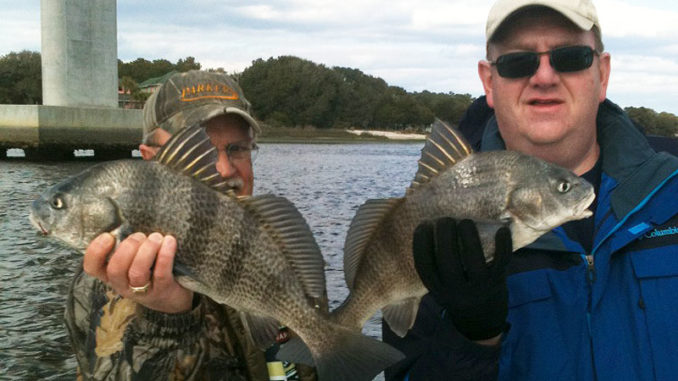
Small estuary holds big numbers of black drum in spring
Spring fishing cranks up this month with plenty of opportunities for small-craft anglers to get into some rod-bending action. Black drum are an often-overlooked winter resident along the South Carolina coast. And March is prime time to target them in Little River’s pint-sized estuary where they hunker down in deep holes most of the winter and wake up hungry.
Black drum prefer a combination of structure and deep water to feed and evade predation. Little River’s estuary along the North Carolina-South Carolina border may be small compared to others. But the available water has all the right ingredients to support a thriving black drum population.
“Black drum will eat shrimp, small crabs, clams, and even small fish. We find them schooled up in places where they can get plenty to eat without a lot of effort,” said Tom Cushman of Capt. Cush’s Calmwater Charters. “Little River has an abundance of deepwater docks on the (Intracoastal) Waterway, oyster rocks and then the jetties themselves. The jetties will hold black drum just about any time of the year.”
It’s no surprise black drum are bottom feeders. They rely on their highly-sensitive barbels to detect potential prey species as they patrol along the bottom adjacent to structures.
Shrimp, clams are good baits on the bottom
Cushman (843-997-5850) will fish along the bottom close to structure using fresh shrimp or clams on a bottom rig or jighead.
“In March and April, the black drum will still be held up in the deeper areas. I like the deeper docks along the waterway, the jetties and holes in some of the deeper creeks in the area,” he said.
Even though fish are beginning to bite more, and the water is warming up, the bite can still be soft because the water in the deep spots may still be on the cool side.
“It can be a real subtle bite. Let them eat for a few seconds, and then reel down on them versus a hard hook set,” Cushman said.
Black drum are known to have strange feeding schedules around the tide. Typically, the bite will be better on the lower end, but it is not always the same throughout the year. It can change seasonally.
“They usually bite on the same tide sequence throughout the day. Once you figure out what stage of the tide they want to feed at your spot, you can count on them to eat,” he said.




